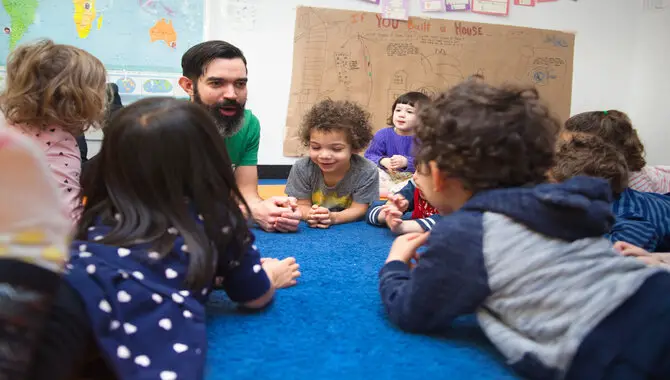A culture of trust is the foundation for an effective classroom management system. It is the cornerstone on which all other aspects of classroom management are built.
A culture of trust creates a safe and supportive learning environment in which students feel comfortable expressing their ideas and sharing their accomplishments. When students feel safe and respected, they are more likely to cooperate and take pride in their work.
Classroom management can be difficult, but teachers and administrators must create a culture of trust to avoid any problems. Here, we will discuss the different aspects of creating a culture of trust in the classroom, provide tips on avoid classroom management problems, and provide practical advice on building a strong culture of trust in your classroom.

About Culture Of Trust In The Classroom
A culture of trust is a key factor in maintaining effective classroom management. A culture of trust begins with establishing clear expectations and communicating them effectively. Consistent rules and procedures help to maintain order and discipline in the classroom, which fosters a climate of mutual respect among students and staff. By fostering a culture of trust, students are more likely to follow the rules and participate fully in class discussions and activities.
This positive environment helps students to develop positive attitudes toward school and learn vital skills for life beyond the classroom.
A culture of trust also helps create an environment conducive to learning. Students with a positive attitude toward school are more likely to put forth effort during lessons and become motivated to learn new things. Overall, a trust culture helps school environments be safe and orderly, allowing students to focus on learning rather than on conflicts or concerns.
Tips To Avoid Classroom Management Problems By Creating A Culture Of Trust
Creating a culture of trust in your classroom is crucial to avoiding classroom management problems. It is important to set clear expectations and ensure everyone knows what is expected of them. Promote a culture of respect by always being respectful and keeping communication open. Ensure all rules are enforced evenly and fairly and that everyone knows about them.
Be consistent in your approach to discipline, and be fair when handing out punishments. Reward good behavior rather than punish bad behavior so that students learn to trust you and follow your rules consistently.
Establish Clear And Concise Expectations
A culture of trust is essential to a successful classroom management system. Teachers can build trust with their students by setting clear and concise expectations. Students will be more engaged and motivated in their learning environment.
Additionally, effective communication skills are key to keeping everyone on track. When all these elements are in place, classrooms will run smoothly, and students will feel supported and motivated.
Respect Individual Autonomy And Privacy
You must maintain respect for individual autonomy and privacy to create a culture of trust in the classroom. Teachers must ensure students feel comfortable speaking up and challenging authority. Additionally, they should model good behavior themselves.
It’s also important to discipline classroom behavior fairly and consistently and punish the use of abusive language or inappropriate actions only as a last resort. Concerning classroom management problems, creating a culture of trust requires patience and consistency.
Foster A Cooperative Environment

Building a culture of trust in your classroom is essential for successful classroom management. Cooperative learning is a type of learning that requires students to work together to solve problems. Thus, creating an environment where students feel comfortable speaking up and asking questions is crucial.
Cooperative learning involves working with others on a shared task or project and can be a powerful way to foster student engagement and achievement.
It’s important to create an environment where students feel comfortable speaking up and asking questions, as this will help them develop the skills necessary for success in the classroom. Creating a trusting culture can improve the learning environment and foster a positive classroom culture.
Encourage Open Dialogue And Feedback.
Creating a culture of trust in your classroom can help to avoid classroom management problems. Encouraging open dialogue and feedback among students is vital to achieving this. Besides, create an environment that allows students to share their thoughts and ideas.
It is also important to communicate rules clearly and consistently. If rules are not communicated clearly or inconsistently applied, students may be reluctant to engage in meaningful dialogue. Additionally, removing obstacles that may prevent students from engaging in meaningful dialogue can go a long way in creating a supportive classroom culture.
Establish Clear Boundaries And Expectations
Creating a culture of trust in the classroom is an important task for teachers and students. Trust is key to a successful classroom environment, and building a culture of trust starts with setting clear boundaries and expectations. A clear hierarchy between students and teachers is essential, as well as clear communication between students.
It is also important to create a safe and comfortable learning environment for all students. Creating a culture of trust requires patience, care, and compassion from both teachers and students. By establishing clear boundaries, expectations, and guidelines for classroom activities, teachers can mitigate the risk of classroom management problems.
Communicate Openly And Honestly With Your Students

Trust is essential to building a culture of trust in your classroom. Open communication is key to building this trust between you and your students. Honesty is also important, as it allows you to resolve conflicts without hurting feelings.
Creating a culture of trust requires setting clear expectations and enforcing them consistently. Among other things, this means rewarding good behavior and punishing bad behavior in a way that is fair and consistent.
It’s important, to be honest with your students about what you expect from them and what behaviors you will tolerate in class. By creating a culture of trust in your classroom, you can foster a respectful learning environment where students are engaged and motivated to learn.
Reward Good Behavior And Discourage Bad Behavior

One way to create a culture of trust in the classroom is by rewarding good behavior and discouraging bad behavior. This can be done through positive reinforcement techniques, such as giving students rewards for behaving well.
Alternatively, bad behavior can be discouraged through negative reinforcement techniques, such as taking away privileges or privileges. It is also important to make sure that all students understand the rules of the classroom and know when to use discipline.
Another way to create a culture of trust in the classroom is by creating consistency and consistency over time. By establishing rules and procedures from day one, you are building a foundation for future success.
Celebrate Successes Together
Creating a culture of trust in your classroom is essential to avoiding classroom management problems. It’s important to celebrate successes together to create a culture of trust. After completing a successful assignment or lesson, it’s a good idea to have a celebratory event, such as a celebration dinner or party.
This way, you can celebrate the accomplishments of the class and establish a positive school culture. It’s also important to set clear rules and expectations at the start of the school year so that everyone in the classroom knows their role and responsibilities. By establishing clear guidelines, you can ensure that your students are learning and achieving their goals within the classroom.
Conclusion
Most classroom management problems can be avoided by creating a culture of trust. As mentioned above, establishing clear expectations and establishing boundaries can help students understand the rules of the classroom and make good decisions while allowing students to work autonomously and offer feedback.
A culture of trust is the foundation of a positive classroom environment. It establishes a safe and supportive learning environment where students feel comfortable sharing their ideas and thoughts.
Building a culture of trust starts with clear and concise expectations, respect for individual autonomy and privacy, a cooperative environment, open dialogue and feedback, and clear boundaries and expectations.
Communicating openly and honestly with your students, as well as celebrating their successes when they succeed, is another way that you can foster a culture of trust. By setting clear expectations and boundaries and frequently communicating with students, you can ensure that everyone in your class is getting the most out of the experience.
Frequently Asked Questions

I’m a writer and blogger who loves to talk about entertainment, culture, and relationships. I love to share my thoughts and insights on these topics, and I’m always looking for new ways to engage with my readers. I’m also a big fan of learning new things, so I’m always exploring new areas of interest.
